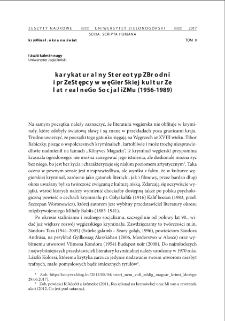Digital Library of Zielona Góra contains 9 283 digital objects
Object
Title: Karykaturalny stereotyp zbrodni i przestępcy w węgierskiej kulturze lat realnego socjalizmu (1956-1989) = Caricature stereotype of crime and criminals in Hungarian culture in years of real socialism (1956-1989)
Contributor:
Ruszczyńska, Marta - red. ; Kulczycka, Dorota - red. nauk. ; Brylla, Wolfgang J. - red. ; Gazdecka, Elżbieta - red.
Group publication title:
Abstract_pl:
W węgierskiej polityce kulturalnej okresu realnego socjalizmu obowiązywała ?zasada trzech T: "Tilt", "Tűr", "Tamogat" (w polskim przekładzie ZTP, czyli Zabroniony, Tolerowany, Popierany). Z powodów ideologicznych kryminał należał do grupy środkowej. Odpowiadał on pewnemu zapotrzebowaniu czytelniczemu. Miał jednocześnie stanowić alternatywę dla zachodnich powieści i filmów kryminalnych, które, podobnie jak w PRL, cieszyły się ogromnym zainteresowaniem w latach 60. i 70. ubiegłego wieku. ; Popularność kryminału wśród czytelników i widzów "wymusiła" więc na władzach tolerowanie jego lokalnej odmiany także w kulturze rodzimej - przynajmniej w porównaniu z okresem poprzednim, stalinowskim, obejmujących lata 1945/6-1956.
Abstract:
In the Hungarian crime-literature, and film at the time of Janos Kadar, ie. in the "Three T": "Tilt", "Tűr", "Tamogat" (in English translation PFS: prohibited, forbear, support), for ideological reasons belonged to a group of middle "T". In the years of socialism, when the crime was officially disappear, foreign detective books attracted great interest in Hungary. ; They constituted an important element of popular culture, and they have contributed their tolerate as a Hungarian varieties of this genre. In the literature of this period they were created by writers stereotypical figure of evil criminals and positive heroes working in the ranks of the militia. With a clear reason it could not then be presented silhouette private detective. ; Detection of the perpetrators of the most frequently represented the fruit of collective work team militiamen. The stereotypical storyline effectively been used for propaganda purposes, as in Polish literature, in the "powieść milicyjna". Tin this paper will be presented some interesting from our point of view literary works and films, which have high artistic level, and are perfectly documents of these times.
Publisher:
Zielona Góra: Oficyna Wydawnicza Uniwersytetu Zielonogórskiego
Format:
Resource Identifier:
Pages:
Source:
Zeszyty Naukowe Uniwersytetu Zielonogórskiego: Seria Scripta Humana, tom 9
Language:
Rights:
Biblioteka Uniwersytetu Zielonogórskiego
Object collections:
- Repository > Faculties > Faculty of Humanities
- Repository > Types of work > Chapters in books
- Repository > Scientific journals and UZ publishing series > Zeszyty Naukowe Uniwersytetu Zielonogórskiego: Seria Scripta Humana
Last modified:
Feb 19, 2024
In our library since:
Feb 8, 2024
Number of object content hits:
121
All available object's versions:
https://zbc.uz.zgora.pl/repozytorium/publication/87166
Show description in RDF format:
Show description in OAI-PMH format:
Objects Similar
Kallas, Piotr Ruszczyńska, Marta - red. Kulczycka, Dorota - red. nauk. Brylla, Wolfgang J. - red. Gazdecka, Elżbieta - red.
Tosik, Magdalena Kulczycka, Dorota - red. nauk. Ruszczyńska, Marta - red. Brylla, Wolfgang J. - red. Gazdecka, Elżbieta - red.
Gazdecka, Elżbieta Kulczycka, Dorota - red. nauk. Ruszczyńska, Marta - red. Brylla, Wolfgang J. - red. Gazdecka, Elżbieta - red.
Samsel-Chojnacka, Monika Kulczycka, Dorota - red. nauk. Ruszczyńska, Marta - red. Brylla, Wolfgang J. - red. Gazdecka, Elżbieta - red.
Dajnowski, Maciej Kulczycka, Dorota - red. nauk. Ruszczyńska, Marta - red. Brylla, Wolfgang J. - red. Gazdecka, Elżbieta - red.
Popielska-Grzybowska, Joanna Kulczycka, Dorota - red. nauk. Ruszczyńska, Marta - red. Brylla, Wolfgang J. - red. Gazdecka, Elżbieta - red.
Zwolińska, Barbara Kulczycka, Dorota - red. nauk. Bielniak, Nel - red. nauk.
Gorzelana, Joanna Kulczycka, Dorota - red. nauk. Ruszczyńska, Marta - red. Brylla, Wolfgang J. - red. Gazdecka, Elżbieta - red.

